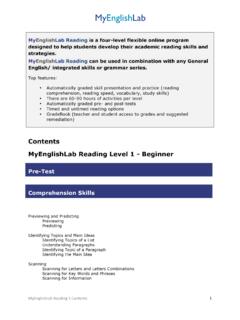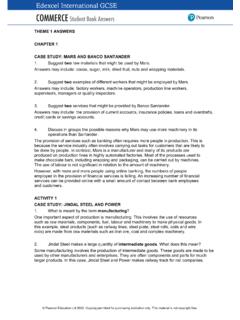Transcription of 31 Nursing Care of Patients with Cardiac Disorders
1 # 151615 Cust: Pearson Au: LeMone Pg. No. 919 Title: Medical-Surgical Nursing : Critical Thinking in Patient care 6eC/M/Y/K Short / NormalDESIGN SERVICES OFS4carliSlePublishing Services91931 Nursing care of Patients with Cardiac DisordersLEARNING OUTCOMES 1. Compare and contrast the etiology, pathophysiology, and manifestations of common Cardiac Disorders , including heart failure, structural Disorders , and inflammatory Disorders . 2. Explain risk factors and preventive measures for Cardiac Disorders such as heart failure, inflammatory Disorders , and valve Disorders .
2 3. Discuss indications for and management of Patients with hemodynamic monitoring. 4. Discuss the effects and Nursing implications for medications commonly prescribed for Patients with Cardiac Disorders . 5. Describe Nursing care for the patient undergoing Cardiac surgery or Cardiac COMPETENCIES 1. Apply knowledge of normal Cardiac anatomy and physiology and assessment techniques in caring for Patients with car-diac Disorders . 2. Assess the functional health status of Patients with Cardiac Disorders , documenting and reporting deviations for ex- pected findings.
3 3. Based on patient assessment and knowledge of the disorder, determine priority Nursing diagnoses. 4. plan , prioritize, and provide evidence-based, individualized care for Patients with Cardiac Disorders . 5. Safely and knowledgeably administer prescribed medica-tions and treatments to Patients with Cardiac Disorders . 6. Actively participate in planning and coordinating interprofes-sional care for Patients with Cardiac Disorders . 7. Provide appropriate teaching and community-based care for Patients with Cardiac Disorders and their families.
4 8. Evaluate the effectiveness of Nursing care , revising the plan of care as needed to promote, maintain, or restore the func-tional health status of Patients with Cardiac CHAPTER CONCEPTS Heart failure, the most common Cardiac disorder, is a condi-tion in which the heart is unable to pump effectively to meet the body s needs for blood and oxygen to the tissues. Heart failure is due to impaired myocardial contraction or excessive workload. Goals of heart failure management are to reduce the work-load and improve its function.
5 Medical management includes medication use including ACE inhibitors, beta-blockers, di-uretics, and vasodilators to reduce the Cardiac workload. Nursing care of the patient with heart failure is primarily sup-portive and educative, providing the patient and family with the necessary knowledge and resources to manage this chronic Disorders affect the structure and/or function of the heart. These Disorders interfere with the heart s primary purpose: to pump enough blood to meet the body s demand for oxygen and nutrients.
6 Disruptions in Cardiac function affect the functioning of other organs and tissues, potentially leading to organ system failure and death. Emergence of symptoms (fatigue, dyspnea, chest pain) is common with the progression of Cardiac Disorders . The New York Heart Association (NYHA) classification is commonly used to describe the severity of exertional symptoms observed (see Table 31 1).aortic valve, 950cardiac tamponade, 947cardiomyopathy, 959endocarditis, 941heart failure, 920hemodynamics, 926mean arterial pressure (MAP), 927mitral valve, 950murmur, 951myocarditis, 945orthopnea, 924paroxysmal nocturnal dyspnea (PND), 924pericarditis, 946pulmonary edema, 935pulmonic valve, 950regurgitation, 939rheumatic fever, 939rheumatic heart disease (RHD), 939stenosis, 939tricuspid valve, 950valvular heart disease, 950 KEY TERMS920 Unit 8 Responses to Altered Cardiovascular Function# 151615 Cust.
7 Pearson Au: LeMone Pg. No. 920 Title: Medical-Surgical Nursing : Critical Thinking in Patient care 6eC/M/Y/K Short / NormalDESIGN SERVICES OFS4carliSlePublishing Servicesprevalence of hypertension in African Americans contributes signifi-cantly to their risk for and incidence of heart , Prevalence, and Risk FactorsMore than million people in the United States are currently living with heart failure; approximately 550,000 new cases of heart failure are diagnosed annually (American Heart Association [AHA], 2013).
8 Estimates predict an additional 3 million people will have heart fail-ure by 2030. Its incidence and prevalence increase with age: Fewer than 5% of people between ages 55 and 64 have heart failure, whereas 6% to 10% of people ages 65 to 74 are affected. There is a rapid rise in heart failure prevalence after age 65. Those ages 75 to 84 have a to person (per) years incidence, while those older than 85 years have a to person-years incidence (see Nurs-ing care of the Older Adult box). At age 40, the lifetime risk of devel-oping heart failure is one in five (AHA, 2013).
9 The estimated direct and indirect cost of heart failure in the United States in 2011 was $ billion. The prevalence and mortality rate for heart failure is higher in African Americans than in Whites. See the accompanying Focus on Cultural Diversity heart disease (coronary heart disease) is the leading risk factor for heart failure. Up to 75% of individuals with heart failure have a history of prognosis for a patient with heart failure depends on its un-derlying cause and how effectively precipitating factors can be treated.
10 Most Patients with heart failure die within 8 years of the diagnosis. The risk for sudden Cardiac death is dramatically increased, occurring at a rate six to nine times that of the general population. In 2009, one in nine death certificates in the United States mentioned heart failure as the primary or a contributing cause of death (AHA, 2013).Physiology ReviewThe mechanical pumping action of Cardiac muscle propels the blood it receives to the pulmonary and systemic vascular systems for reoxy-genation and delivery to the tissues.









